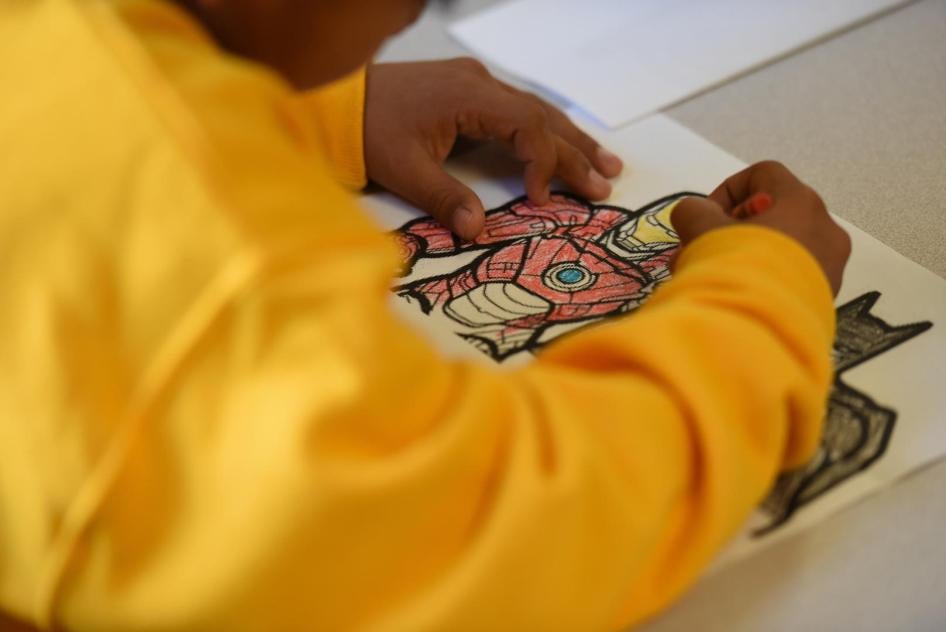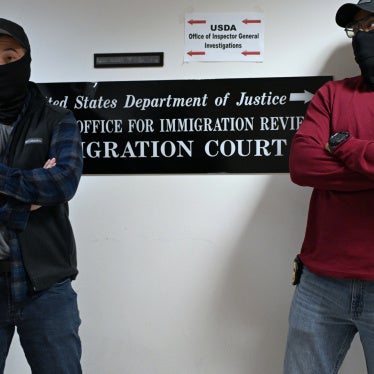Murderous violence. Sexual assault. Criminal gangs. Domestic abuse. Failed governments. Police unwilling or unable to offer protection. These are the reasons child after child gave for coming to the United States in search of safety, as we interviewed them in the US Border Patrol facilities in El Paso, Texas, in June.
Many of the children had plausible claims to asylum that should be seriously considered, and every child had the right to be treated humanely and with dignity. Yet many broke down in tears as they described abuse and severe neglect at the hands of the US government: hunger, cruelty, lice and flu spreading through the cells, and sleeping on concrete floors, in tents, a windowless warehouse, a loading dock. For days. Weeks in some cases. Some described assaults by Border Patrol agents.
“Nobody takes care of us here,” an 11-year-old boy told us. “I try to take care of my little brother and sister since no one will take care of them. There are little kids here who have no one to take care of them . . . . Some kids are only 2 or 3 years old and they have no one to take care of them.”
As the stories unfolded in interview after interview, we wondered what would end the systematic abuse of these children— what combination of public pressure, media attention, legal change, litigation, and other strategies could push officials to do the right thing.
We considered whether international law could help. Probably not, at least not directly. Although the United States has actively participated in building the international legal framework that protects children’s rights, it has been loath to bind its own conduct by international norms.
All of the children we interviewed were without parents, except a few babies and toddlers whose parents were children themselves. We saw older children struggling to care for younger ones, often children they did not know.
After thousands of children were forcibly separated from their families, President Donald J. Trump announced an end to the family separation policy in June 2018 and a federal court ordered the reunification of separated families the same month. And yet child after child sat before us describing when and how US officials forcibly separated them from their families this year.
Children showed us tiny slips of paper they had tucked away in their pockets containing US telephone numbers for parents, grandparents, aunts, uncles, siblings, cousins. Sometimes the children recited memorized numbers.
When we used our cell phones so children could speak to their loved ones for the first time in days or weeks, we saw tears and smiles as the calls were immediately answered or returned. Both sides tried to assure the other that they would be together soon, but we, and likely they, knew better.
By law, children shouldn’t be in Border Patrol custody more than 72 hours. The government gets some leeway if the number of arrivals is such that it can’t do that, but children should be promptly transferred to US Department of Health and Human Services custody. From there, children should be reunified with family in the US or, if no family member could care for the child, with another caregiver.
These transfers are supposed to take place as expeditiously as possible, and in no case more than 20 days from the time children enter Border Patrol custody. Earlier this year, the Border Patrol was detaining children for more than 90 days on average, in violation of both these legal limits and the children’s rights.
There are elements of international law that could help. Take, for example, the UN Convention on the Rights of the Child. The convention is the most widely ratified human rights treaty in the world. The United States contributed substantially to drafting the convention between 1979 and 1989.
It then took six years for the United States to sign the treaty, in 1995, and since that time, no president has ever sent it to the US Senate for ratification, the formal agreement to be bound by its terms. The United States remains the lone holdout among UN member countries.
Some of the specific terms of the Convention on the Rights of the Child are now norms of customary international law, meaning that a global consensus has emerged that all countries are obligated to respect certain children’s rights.
An example is the death penalty for crimes committed by children. Only a handful of countries sentence children to death and fewer carry out these sentences—and most of those do so furtively rather than claiming the right to execute juvenile offenders. The Supreme Court opinion striking down the juvenile death penalty in the United States in 2005 cited “the stark reality that the United States is the only country in the world that continues to give official sanction to the juvenile death penalty,” coming close to but not acknowledging that international consensus was such that a norm of customary international had emerged against the practice.
In the same way that the world has recognized that children should not be executed, it has also recognized that children belong with family, unless that’s not in an individual child’s best interests, and that they should never be abused or neglected.
Additionally, the United States has ratified the International Covenant on Civil and Political Rights. As a party to that treaty, United States has agreed to protect the family and to give children special protection.
To be sure, the principle of family unity isn’t an absolute, as the prohibition on the juvenile death penalty is. And abuse and neglect cover a wide range of acts; it’s not always straightforward to determine what conduct amounts to these violations.
Assuming those issues can be resolved, what could be accomplished if one made a strong argument that US violations of children’s rights violated US obligations under international law?
Like many human rights treaties, the Convention on the Rights of the Child was intended to establish international norms. It did not initially have an enforcement mechanism. Instead, states submit country reports for review every five years. An enforcement option recently came into force, but as we might expect given the US failure to ratify the convention itself, the United States has not signed or ratified that protocol.
The Convention on the Rights of the Child is just one of many human rights treaties that the US has failed to ratify, including treaties intended to eliminate discrimination against women, to enumerate everyone’s economic, social, and cultural rights, to protect migrant workers and their families, to fortify the rights of people with disabilities, and to establish the International Criminal Court to hold those responsible for war crimes and genocide accountable.
So what international recourse do these children have?
One possibility is the regular accounting every UN member has to make at the Human Rights Council, a process known as Universal Periodic Review. In May 2020, when the United States is up next, every other UN member will be able to ask questions and make comments and recommendations on US respect for the Universal Declaration of Human Rights, its voluntary commitments, and its treaty and customary international law obligations. Until mid-September, nongovernmental organizations can submit information—including statements from detained children themselves—to inform these discussions.
Universal Periodic Review is not a court process, and it can’t compel countries to take action. But it’s the only human rights process that covers all UN members, and its scope is broad. There’s a real value in the political pressure of regular review by other countries.
In the near term, real change will most likely have to come through domestic strategies. That means the kind of litigation capably pursued by the American Civil Liberties Union and other groups. It means Congressional oversight and legal changes to strengthen instead of weaken protections. It means the US government taking on board the recommendations of the UN Human Rights Council and other UN experts. It means overhauling agencies that have a track record of abuse, and effective internal accountability systems, and prosecution for egregious misconduct.
Most of all, it means public pressure.
That means showing opposition to cruelty—by peaceful protest, by writing or calling lawmakers on both sides of the aisle, and by respectful discussion in communities throughout the country.
It means amplifying the voices of detained children and asking others to do the same.
Whatever approaches are used—as many in combination as possible, ideally—they will have to persuade the president and Congress that inhumanity is unacceptable.
Two successive summers of public outrage have yet to do that. But sooner or later, we will reach a tipping point, hopefully one that persuades policymakers that cruelty to children and their families is a losing proposition.
Michael Garcia Bochenek is senior children’s rights counsel at Human Rights Watch. Warren Binford is a professor of law and director of the Clinical Law Program at Willamette University.






